World conference sets new climate pact

COP26, the annual Conference of the Parties aimed at building cooperation among world leaders to address the climate crisis, took place earlier this month. Delegates (and protesters) came from all over the world to discuss the critical issue.
The result was an official conference of the parties climate pact that mentioned fossil fuels — the dominant cause of climate change — for the first time ever. For fossil fuels to be explicitly included in the official text is a significant win. Some other takeaways from the conference:
Not so great news:
- A last-minute change to the draft resolution, introduced by India, watered down language on phasing out coal. The revision called for countries to phase down coal, instead of aiming to phase it out completely.
- Current pledges are based on flawed data, according to The Washington Post. The Post investigation implies that many countries are underestimating their greenhouse gas emissions and, therefore, are not setting adequate goals.
- The conference ended without firm commitments to properly protect vulnerable countries. The pact only urges wealthy countries — which are disproportionately responsible for global warming — to fulfill dated promises of $100 billion in annual aid to vulnerable countries.
The good news:
- More businesses are shifting their sustainability from an add-on to a must-have. A recent blog from McKinsey, the global management consulting firm, underlines how essential it is for businesses to plan how they will achieve Net Zero.
- A major deal on regulating carbon markets will advance cooperation among nations. COP26 addressed a challenging aspect of the Paris agreement known as Article 6, establishing an agreement to allow countries that exceed their emissions reduction goals to sell their extra progress to nations that are lagging behind.
- More than 100 countries agreed to end deforestation by 2030, affecting roughly 85% of the world’s forests. Forests play a critical role in absorbing and storing carbon dioxide and slowing the speed of global warming.
And one takeaway specific to health care systems: Fifty countries agreed to develop climate-smart health care, committing to building resilience to climate impacts (such as extreme weather) within health systems, as well as to reducing emissions.
That commitment affirms the significance of climate change as a health challenge and health systems’ role in addressing it. The med center already is making strides toward this climate-smart future with its 2030 Net Zero Building Emissions goal.
Instead of Black Friday, try Buy Nothing Day

As the holidays approach, we are often inundated with Black Friday Deals and “must-have” gift ideas. This year, we instead are highlighting Buy Nothing Day.
Founded in 1992, Buy Nothing Day is observed the Friday following Thanksgiving. As the name implies, the goal is to buy nothing, while also increasing awareness of consumerism and promoting alternative forms of gift-giving.
Buy Nothing has grown into a movement of neighborhood gift-giving all over the world.
The impacts of consumerism are widespread. The production and distribution supply chain alone has a devastating effect on our environment. We are currently overusing Earth’s natural resources by more than 70 percent. If the Earth’s population as a whole began to consume as the average American does, we would need 5.2 planets to support us.
Plus, landfills and natural environments are overrun with trash due to excess and throwaway culture. Multiple studies have concluded staggering facts on plastic waste: Only 9% of plastic waste is recycled in the United States, and 40% of plastic produced is single-use packaging.
Not surprisingly, public health is affected by consumerism. As companies try to meet demand and turn a profit, unfair labor practices run rampant. Commonly reported conditions include child labor, long hours, low wages, physical abuse and unsafe practices. Globally each year, more than 2.1 million deaths are attributed to poor working conditions. Unfortunately, many of us have likely purchased an item with a troubled history as many large, name-brand businesses often outsource their manufacturing.
What can we do about it? Shifting our habits and spreading awareness about the impacts of consumerism can lead companies to change their practices and reduce harm to the environment and the workforce.
Many of us still want to give our loved ones thoughtful gifts — and we can, because there are so many different ways to do so. Many suppliers are ethical and environmentally conscious. Shopping locally supports neighbors, small businesses, local economies and the environment.
Or perhaps the perfect gift is already out there. “Pre-loved” gifts are often unique and can have great value. Check out local thrift shops or garage sales, Nextdoor, OfferUp or a Buy Nothing Group on Facebook. Another option is to purchase experiences as gifts — such as tickets to concerts or sporting events — instead of manufactured goods.
Meet Jerrod Bley, UNMC’s new sustainability manager

Jerrod Bley brings technical expertise and great passion to his role as the new sustainability manager at UNMC and Nebraska Medicine.
Bley holds a bachelor’s degree from the University of Nebraska-Lincoln in environmental studies, with minors in energy science and business. He earned a master’s degree in engineering management from Montana State University, as well as several renewable energy certifications. He has worked on energy conservation and efficiency initiatives, including installing units for grid-tied photovoltaic, off-grid solar, solar thermal and small wind projects.
 |
| Jerrod Bley |
As a member of a Marine Corps engineering unit, Bley worked in numerous settings within the renewable energy sector. At the Montana Weatherization Training Center in Bozeman, he served as clean energy project manager and worked up to facility director. Through this work, he provided training and education in weatherization and building science as well as health and safety throughout the Intermountain Region.
Most recently, Bley was clean energy program director for the Adirondack North Country Association (ANCA) — a mission-driven economic development in the heart of the Adirondacks. Through the Adirondack Diversity Initiative, his team received the tools to design and develop programs framed by cultural consciousness and centered on racial equity. Those efforts aimed to support an economy that worked for all. Bley also was appointed to New York State’s climate justice working group, an advisory body to the climate action council.
Bley looks forward to contributing to UNMC’s campus goals to become carbon neutral and zero waste by 2030 and supporting efforts toward equitable access to multimodal transit and mobility. He is eager to expand his understanding of the socio-psychological underpinnings of sustainable behavior change.
“It’s exciting to challenge conventional thinking about how we can operationalize strategies that are both proof of concept and cutting edge to achieve our ambitious goals,” Bley said. “In my line of work, I’m humbled on a daily basis by the amount of effort and diligence that still remains to truly effect change at the societal level to achieve a meaningful and permanent paradigm shift with respect to a sustainable future.”
Bley loves spending time with his wife and two young children. He welcomes anything that brings him outdoors, including backpacking, bowhunting, paddling and fly-fishing. Bley is an avid fermenter and can be spotted reading Sandor Katz and perfecting his lacto-fermenting craft – anything from kimchi to sourdough.
Campus Sustainability Month roundtable recap
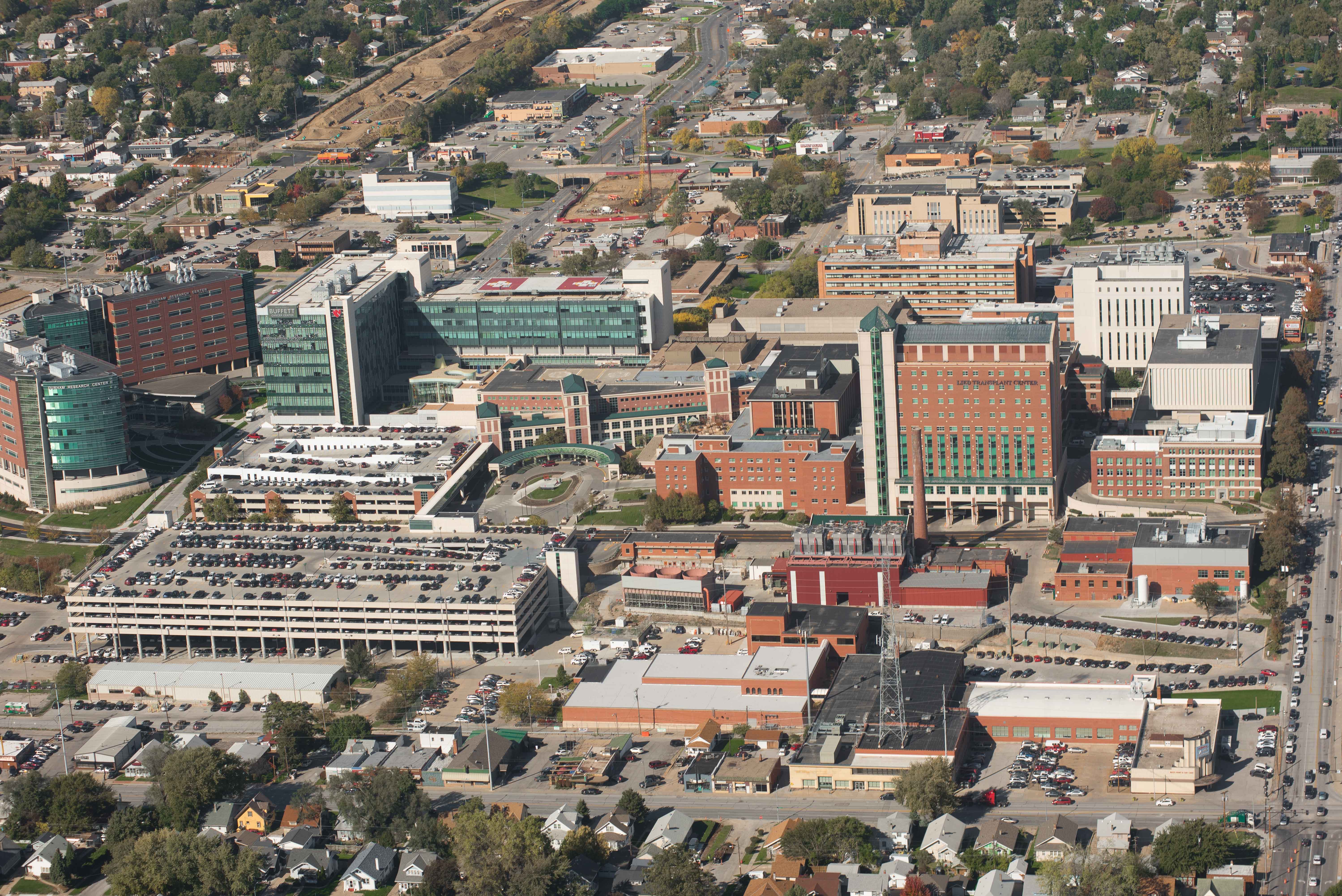
For Campus Sustainability Month, UNMC collaborated with other higher education institutions to host a virtual roundtable. The event showcased a few remarkable locals with different areas of expertise, each with helpful takeaways for attendees.
Leigh Neary, owner of Exist Green in Dundee, started off by emphasizing the importance of recognizing our relationship with objects and considering their overall journey. Exist Green is a zero-waste market and eco-boutique with a central focus on building lives around plastic-free reusables and using sustainable consumables with life-cycles consumers can fully understand.
Neary revised the adage of reduce, reuse, recycle by changing it to refuse, reuse, rot and recycle. Acknowledging the traditional practice of extraction, production, distribution, consumption and disposal allows us to pivot by opting to repair, buy secondhand, compost and recycle.
Jason Rose, communications and community relations manager at Metro transit, provided insight on the future of public transit in Omaha and highlighted the direct connection between public transit and sustainability. One of the staggering yet motivating statistics that Rose provided: “U.S. public transportation saves 37 million metric tons of carbon dioxide annually.” Metro is aiding the call for change by rethinking and diversifying fuel sources and purchasing a fleet of electric buses.
Jesse Bell, PhD, Claire M. Hubbard Professor at UNMC, gave a thorough assessment of climate change and its ongoing effects, such as extreme weather events. Dr. Bell provided helpful local and social context and highlighted the unfortunate reality that climate impacts vary by socioeconomic background.
He also shared information about the efforts undertaken by students at UNMC to push the university toward greater accountability and to incorporate climate change education into curriculum. Check out the Healthy Earth Alliance (HEAL) for additional related efforts.
Dawaune Lamont Hayes, journalist, graphic designer and founder of Noise Omaha, wrapped up the evening by discussing how art plays a significant role in climate resiliency and advocacy for the built environment. Art and information go hand-in-hand as images capture and reflect who we are and our lasting influences. Hayes also stressed that expressive vocabulary is equally essential to humanizing goals and communicating efforts. Additional information on Dawaune’s projects can be found at Dawaune.one – life is creative.
Those who missed the event can watch the recording here.
World Vegan Month
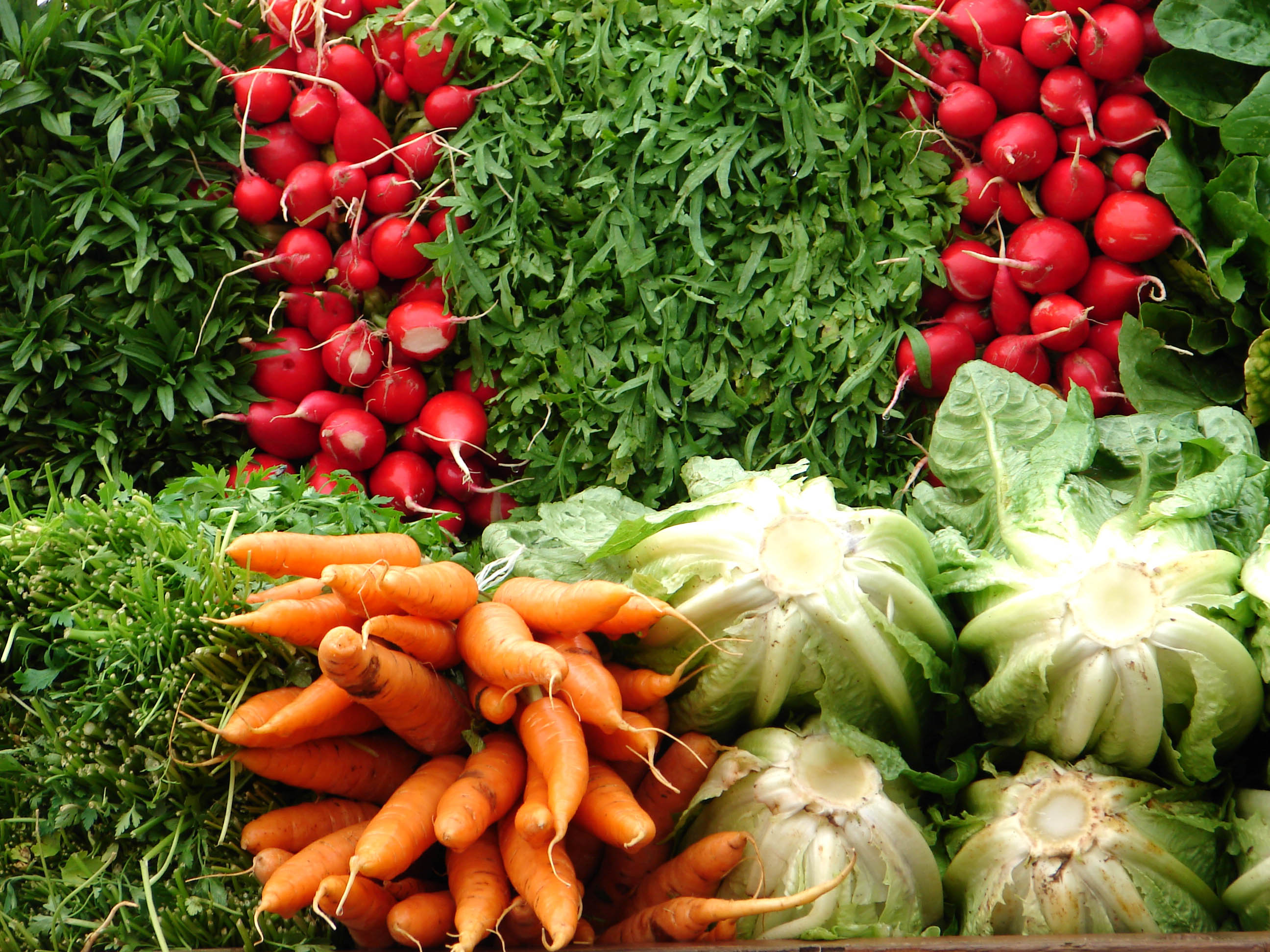
In late September, we touched on World Vegetarian Day by sharing various ways that reducing the consumption of animal products can benefit public health, animal welfare and the environment. As we transition into November, it’s time to reflect on World Vegan Month.
The benefits gained from a vegetarian lifestyle increase exponentially when making the shift to veganism, which excludes all animal products (e.g., dairy products), not just meat. In fact, in addition to the health benefits, an Oxford University study shows that “going vegan is the ‘single biggest way’ to reduce your impact on the planet.”
The modern era offers breakthrough advancements and countless resources to reach our personal lifestyle and health goals. However, as inspired as we may be to embark on new journeys, the research process may be equally as daunting. We’ve compiled a few “get started” tips and popular recipes to further highlight the benefits of eating vegan and the ease of the transition.
An excellent place to start is to consider which recipes or products you already enjoy that happen to be “accidentally vegan.” Likewise, think of some favorite whole foods that could be seamlessly swapped for typical meat and dairy choices. A popular example is supplementing red meat in dishes with portobello mushrooms or eggplant, because they both add texture, flavor and richness, similar to meat. Both options increase your vegetable intake for the day, as well.
Few people have time to prepare every meal, so what are some quick options? Many grocery stores carry a wide variety of pre-packaged, vegan-friendly options. Commonly reached-for products include veggie burgers, plant-based “eggs,” dairy-free sour cream and dairy-free cheeses. On the flip side, what about social occasions such as dinner parties? A fantastic way to contribute while allowing for your needs is to offer to bring a dish to share. This chipotle cashew queso always is a hit.
As with any major change in health or lifestyle, discussing individual needs with your medical professional is recommended. Your caregiver will provide appropriate consultation based on specific needs. Such recommendations may include the importance of supplementing your journey with vitamins and minerals to ensure you are receiving the optimum benefits of your chosen diet.
A green Halloween

This Sunday is Halloween. Below are some tips and tricks for making your celebration a more sustainable one.
Consumer spending on Halloween-related items is expected to reach an all-time high of about $10 billion, up from $8 billion in 2020, according to the National Retail Federation. This mostly is due to costumes, candy, decorations and greeting cards. The amount of waste created from these items — from single-use costumes to plastic candy wrappers — is significant but can be avoided. Reducing waste and choosing more sustainable options means fewer greenhouse gas emissions and a healthier holiday.
Costumes: Before you go out and buy a new costume or new clothing/accessories to use for your costume, see if you already have anything you can use. You also can check out local thrift stores like the ones mentioned here, or vintage boutiques, which always have great costume pieces. Or talk to your friends, family or local Buy Nothing group to see if you can swap previously worn costumes.
Decorations: Luckily, one of the best decorations for Halloween is a vegetable — the pumpkin. Most people just toss their pumpkin after they are done carving it or using it as a decoration. Instead, try roasting the seeds for a healthy snack or using the remaining pumpkin flesh in recipes like these, or you can fill the pumpkin with seeds to feed wildlife. Finally, make sure to compost your pumpkin. You can drop it off at one of Hillside Solutions/Dundee Bank’s free pumpkin composting collection sites. For other decorations, try to reuse materials and create your own – such as turning ripped stockings into spider webs — or purchase durable decorations that can be used every year.
Candy: Look for treats with minimal packaging and/or those packaged in recycled materials or choose alternatives to the typical candy options. Some of the world’s largest candy companies have a large environmental impact, through deforestation, species extinction and emissions from the harvesting of sugar, palm oil and cocoa beans. Products with certifications like organic and fair trade are generally safer options, or you can hand out healthier options like popcorn or juice boxes. Contrary to popular belief, lots of kids and parents alike will be happy to have a better variety in their bucket.
This Halloween, don’t just think orange — think green.
The greening of the wear

With colder weather rapidly approaching, it’s the perfect time to clean out your closet.
If you happen to decide there are some items you are ready to give up, don’t throw them away. Donating is a more eco-friendly option for discarding these items.
The fashion industry accounts for around 10% of annual carbon emissions and every year uses around 93 billion cubic meters of water — enough to meet the consumption needs of 5 million people. On top of that, around 92 million tons of textile waste is created every year by the fashion industry. You can significantly reduce the impact on the environment created by the fashion industry by only buying clothes you need and donating clothes you no longer want.
You can donate your clothes to many different organizations in Omaha. There is a wide range in what organizations will accept. Some places will buy your clothes in good condition, and other places will accept any type of donation you can give.
Here is a list of places in Omaha you can donate to:
|
Organizations that will buy clothes in good condition |
Organizations that will take donations in good/decent condition |
Organizations that will take any donations |
Another positive aspect of these organizations is that you can shop at most of them and it’s much cheaper than buying brand new. Thrifting/upcycling is a fun and sustainable way to shop and give other people’s discarded items a new home.
Campus Sustainability Month
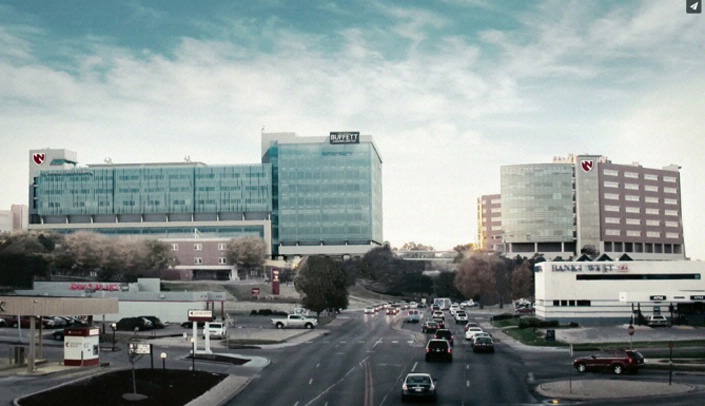
UNMC will join campuses across Omaha and nationwide in celebrating Campus Sustainability Month this October.
Hosting Campus Sustainability Month is a nice juxtaposition to Earth Month events in April, and the month often serves as a catalyst for student involvement on campus.
Academic campuses are essential drivers to the environmental movement. In large part, colleges and universities’ interests in sustainability stem from student interests; UNESCO reports that 91% of students agree that their higher education institution should actively pursue and promote sustainable development. Academic institutions pursuing environmental sustainability and climate change resiliency often partner with their local communities, which has positive effects on not just the campus, but the residents, municipalities and land surrounding the institution as well.
Campus Sustainability Month will look different this year as a result of the ongoing COVID-19 pandemic. Last week, we celebrated by planting a tree as part of the Free Trees for Fall Planting grant. You can get involved by participating in the other activities we have planned for this month:
- People’s EcoChallenge: You can join the med center’s team that will compete in the People’s EcoChallenge, a month-long virtual challenge (Oct. 6-Oct 27) where participants pledge and then record a variety of sustainable activities. Friends and family are welcome.
- Virtual Roundtable Event: On Oct. 25 from 6-7 p.m., join us for a roundtable with guest speakers from Keep Omaha Beautiful, Metro Transit, Exist Green and UNMC’s Water, Climate and Health Program. Our guests will cover recycling, public transportation, zero waste living, and climate change and health. Each speaker will present for less than 10 minutes, and there will be an opportunity for Q&A at the end. There might even be an opportunity to win giveaways. Click here to register for the Zoom event. After registering, you will receive a confirmation email containing information about joining the meeting.
Med center to plant new trees on campus
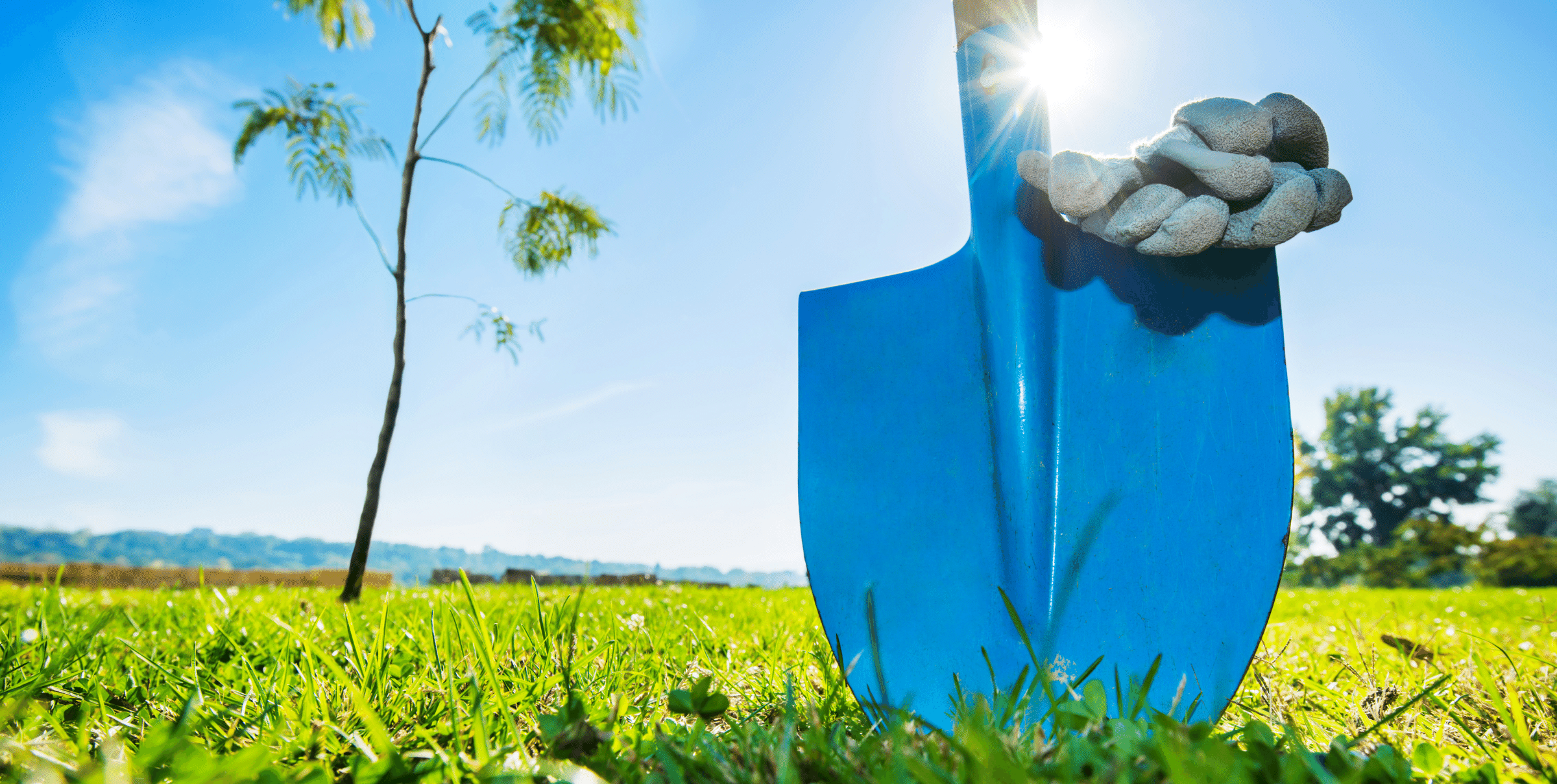
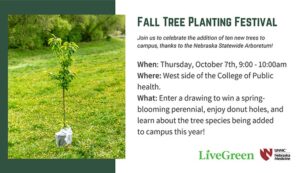
For the third year in a row, the med center has received the “Free Trees for Fall Planting” grant, a collaborative effort of the Nebraska Forest Service (NFS) and Nebraska Statewide Arboretum (NSA).
In September, the med center received 10 trees with six different tree species, including black cherry, Kentucky coffeetree, and Hastings American elms.
Fall is the best time to plant trees, because the warm soil helps new root formation and the air temperatures encourage trees to produce shoots. The new trees will be planted on Thursday, Oct. 7 from 9-10 a.m. on the west side of the UNMC College of Public Health as part of Campus Sustainability Month. Attendees at the planting can enter a drawing to win a spring-blooming perennial, enjoy donut holes and learn about the tree species being added to campus this year.
Some of the new trees will replace trees that fell due to storms this past spring and summer. Trees will be planted near Clarkson College, the Maurer Center for Public Health and the Field Club Trail – all highly populated areas. Adding trees in these locations will create more shade and add to the general tree canopy system, which helps cool down highly populated areas. Having more trees at the med center also benefits the environment, with effects that include:
- Acting as a carbon sink and cleaning the air
- Adding biodiversity and attracting different pollinators
- Reducing emissions from lawn mowing
- Cooling the streets and city by breaking up urban “heat islands”
- Preventing soil erosion and water pollution
Plus, having more natural areas on campus helps with human health and healing. In 2020, Yale Environment posted a study that observed the effects of spending two hours a week in green spaces (parks or natural environments) on human well-being. The study showed that people who spent more time in green spaces reported having better health and psychological well-being when compared to those who didn’t. Nature can relieve stress by lowering blood pressure and stress hormone levels, reducing nervous system arousal, aiding the immune system and improving mood. Find more information on the positive effects trees have on health, especially in urban areas, here.
Friday is World Vegetarian Day
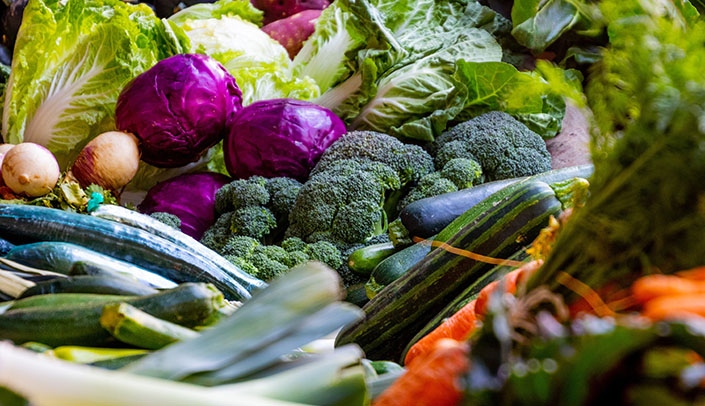
World Vegetarian Day is observed annually on Oct. 1. Its aim is to bring awareness about the benefits of a vegetarian diet on human health, animal welfare, the environment and more.
Eating less meat is one of the most significant ways an individual can reduce their environmental impact while also improving their own health.
According to the American Dietetic Association, eating a well-planned vegetarian diet may help reduce the risk of certain diseases, including heart disease. In fact, “a growing body of scientific evidence indicates that wholesome vegetarian diets offer distinct advantages compared to diets containing meat and other foods of animal origin” due to higher levels of certain nutrients and lower levels of saturated fat and cholesterol. Vegetarian diets can be beneficial in the prevention and treatment of everything from cardiovascular disease and hypertension to diabetes to cancer, osteoporosis and a variety of other conditions.
The livestock industry is responsible for about 14.5% of global greenhouse gas emissions, and cattle (both meat and dairy production) account for 65% of those emissions. Widespread adoption of vegetarianism would have a significant impact on emissions worldwide. It also could save as much as $1 trillion annually in health care costs and lost productivity — and could save around 7 million lives. Widespread veganism (no animal-based products) would have an even greater impact.
If cutting out meat from your diet entirely sounds too difficult, try starting small. Eliminate meat for one day or one meal a week, or replace meat with a substitute such as tofu or plant-based alternatives. By experimenting with new vegetarian recipes on that day, you can find out which dishes you can easily include in your regular routine. One of the common mistakes people make when they become vegetarian is to eat more processed food, which negates the health benefits. Instead, be sure you do a little research about the nutrients you need and how you can get them through plants. Soon, you’ll be on your way to helping drastically cut greenhouse gas emissions and improving your health.
